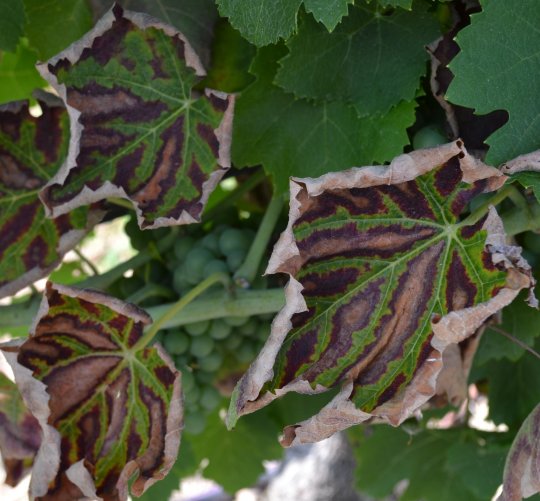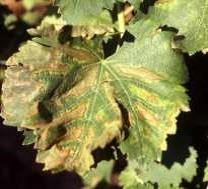Black Dead Arm (BDA), also called Botryosphaeriose, was first identified in 1999 in France, and for a long time its symptoms were attributed to ESCA. BDA affects both young and established plots and is now recorded in many vineyards and appears in several forms.
2.4.2.c Black Dead Arm
What damage is caused by BDA in the vineyard?
Symptoms begin to appear during the flowering period following high temperatures and continue to appear regularly throughout the growth period. They affect either the whole plant or only one arm. The lower leaves are the first to be affected. The symptoms can evolve very quickly (in the severe or defoliating form) or pass through different stages (slow form), leading to premature dropping of the leaves. The symptoms can vary significantly from one year to the next. A diseased plant one year may very well appear healthy the following year.
-
The severe form is characterized by a drying of the inflorescences or clusters as well as rapid defoliation of the branches, which may dry out partially or completely. The desiccation starts at the apical part of the branches. It differs from apoplexy in that the inflorescences or clusters dry out before the leaves fall and then the branches dry out.
-
The slow form of the disease results in a delay in the ripening of the grapes and a deterioration of the foliage, which can give a tiger-stripe appearance to the leaves. At an early stage of the disease, the leaves show wine-red (black grape varieties) or bright yellow (white grape varieties) spots, and/or necrotic spots bordered by a wine-red (black grape varieties) or bright yellow (white grape varieties) border.
Their evolution can lead to leaf symptoms similar to the slow form of Esca due to the lightening of tissue, the wine-red becoming light red and the green becoming light yellow.
In addition to this form of expression, it is also possible to observe necrotic areas developed to varying degrees resulting in a loss of turgidity of certain parts of the leaves. In black grape varieties, they turn greenish-grey, while white grape varieties turn orangey-grey. All these forms of expression of varying intensity (defoliating forms, different facies of the slow form) can be observed on the same vine.
Weakening of the vegetation: affected plants are also characterized by dying branches and spurs or weakened vegetation. This last symptom is not disease-specific. It is the result of a weakening of the vine which can have various origins (Syrah dieback, root rot, etc.).
Apoplectic form: this is characterized by a rapid wilting of all or part of the vegetation. The foliage, branches and bunches dry up in a few days. Contrary to the severe form of BDA or defoliating form, the dried leaves remain on the branches longer and the bunches dry up last. It is usually encountered during dry periods or strong winds, due to high evapotranspiration which is not compensated by sufficient water inflow because of a reduced proportion of functional wood. Apoplexy can be due to other causes such as root rot, black foot, eutypiosis, strangulation of the rootstock by the graft, very poor pruning, etc.
Within the wood, this disease is characterized by the presence of a brown band beneath the bark, originating from the diseased branch and which can go down to the joint, or even into the rootstock. In a cross-section of the wood, it appears as a yellow to orange area, only a few millimetres deep, in which the vessels are obstructed.
The number of affected vessels, which also depends on the width of the brown band or the volume, influences the severity of the symptoms observed in the vineyard, ranging from the slow form to the severe defoliating form. It is important to note that the brown band is not present in weakened or apoplectic vines. Grey sectoral necrosis can also be observed on affected vines.
What fungi cause BDA? What is their biology?
Among the fungi associated with BDA, the most common species are Diplodia seriata, Neofusicoccum parvum and Diplodia mutila. These microorganisms are also found in other woody plants. Their life cycle is still poorly understood. Dissemination is airborne, mainly during the growth period. The inoculum is preserved on old pruning wounds, bark from spurs, as well as on the vine's trunk and pruning wood left on the ground. It is unclear how these fungi enter the vine. Propagation in the nursery by grafts, rootstocks and grafted vines is possible.
Are there any preventive measures?
Prophylactic methods of control are the same as for contamination by Esca
Extract from Vigne Vin Occitanie





